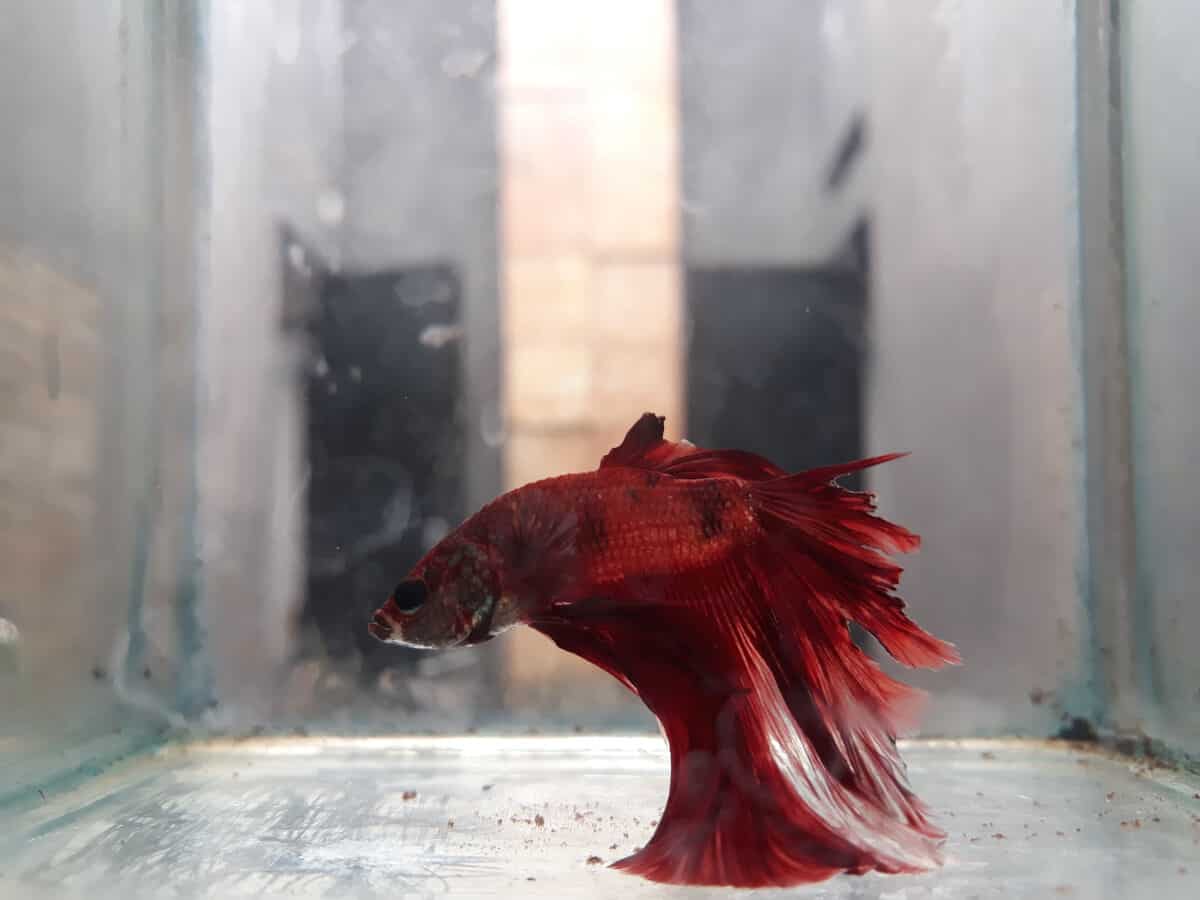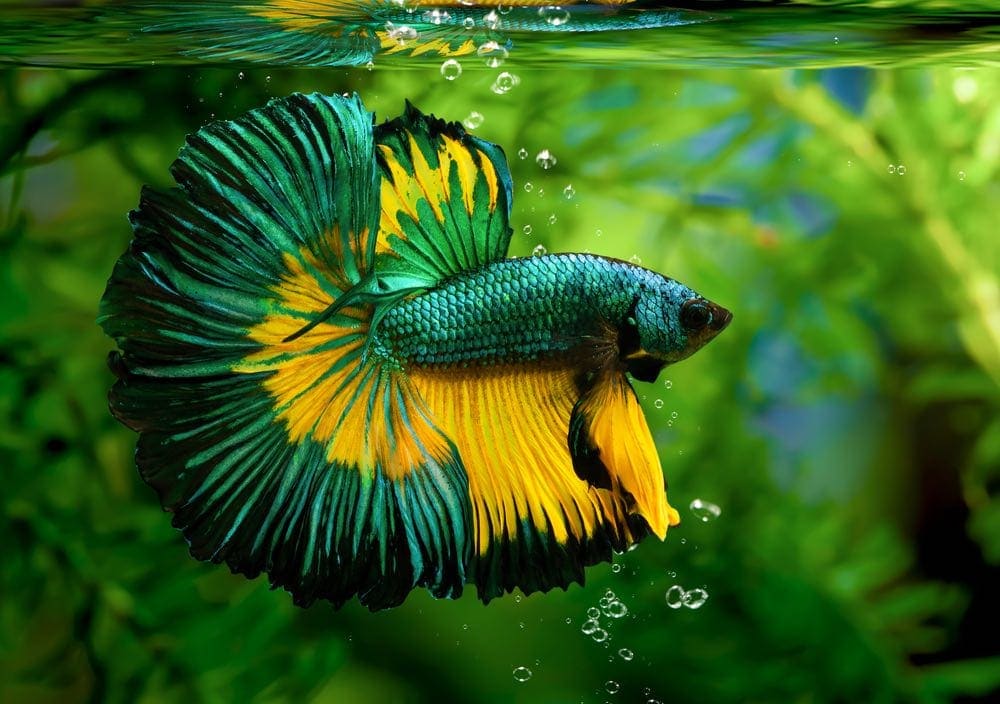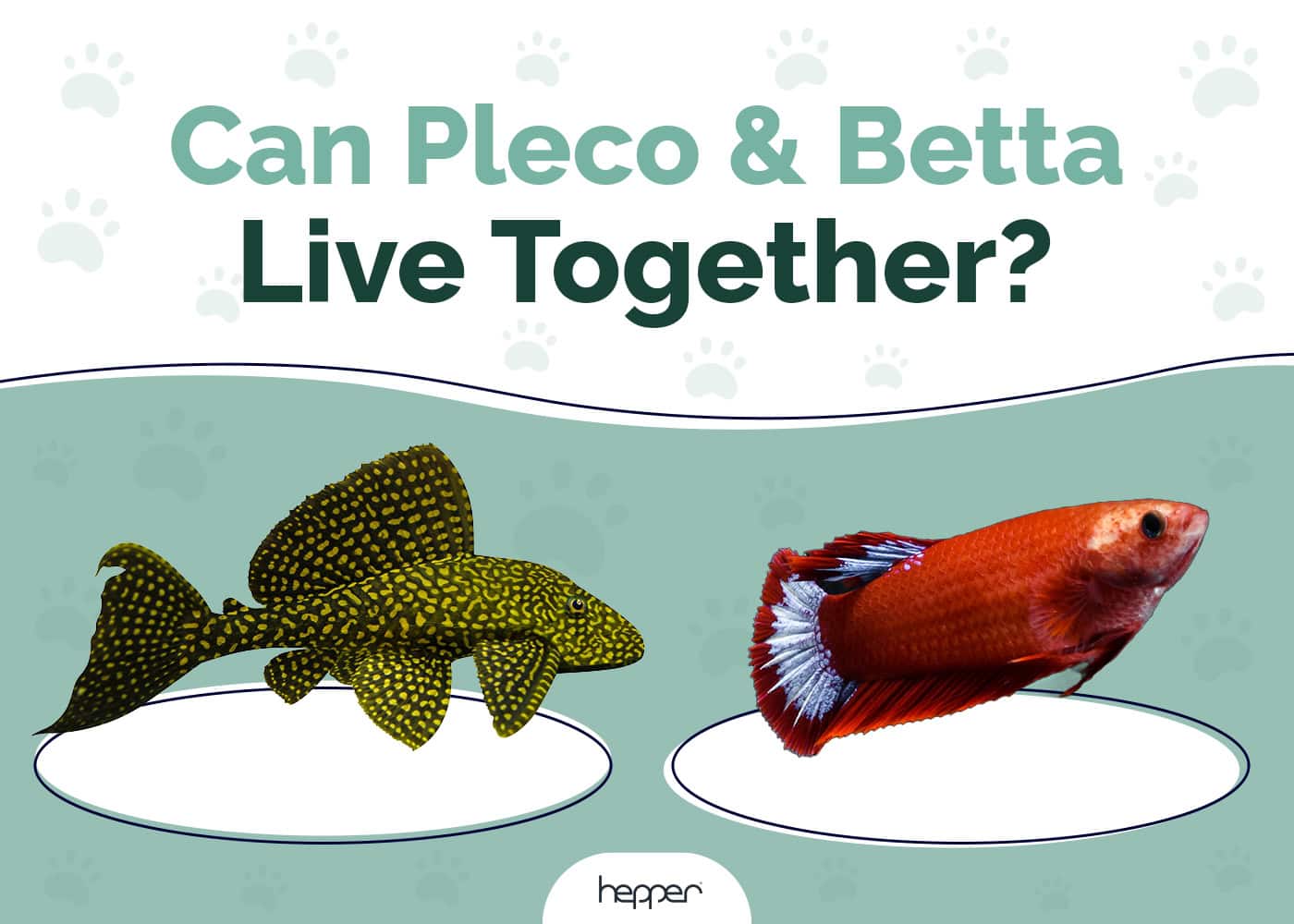12 Safe Betta Fish Tank Mates: Vet-Approved Compatibility Guide

Updated on
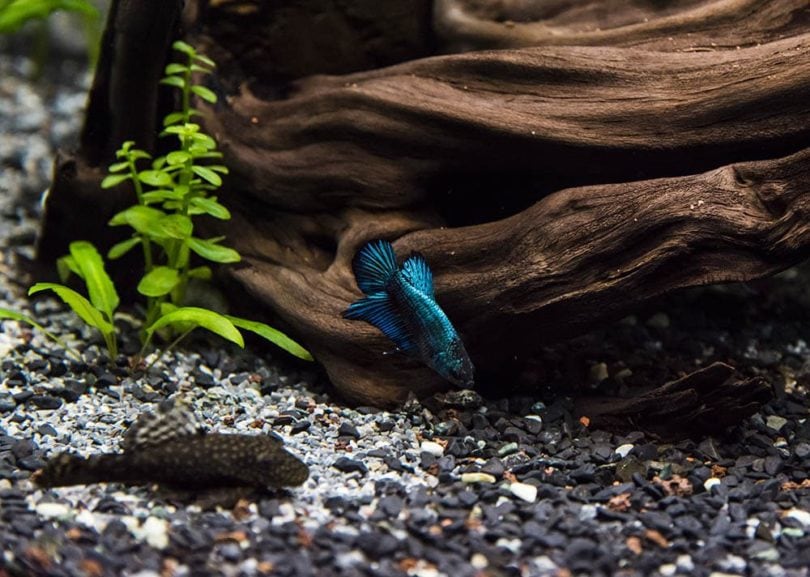
There’s something about a showy, flowy tail that attracts many aquarists. It’s mesmerizing to watch them rippling in the current, or fluttering as the fish makes a sudden turn or dive. That’s part of the reason why fish like ornamental goldfish, guppies, and bettas are so popular.
And what’s better than one pretty tail? More pretty tails, of course!
A tank teeming with beautiful fish is a glorious sight. But, if you’ve chosen a dramatic betta for your tank, is it even possible to add to the fun?
In this article, we’ll explore the feasibility and desirability of keeping a betta in a community tank, recommending for you the best betta tank mates.
Do Betta Fish Need Tank Mates?
Bettas are almost invariably displayed in stores in small cups or tanks, and they are always alone. From this one might conclude they don’t want or need company. And you would be correct in this conclusion.
Bettas are not schooling fish, nor do they pair with mates. They prefer to have their own space at all times unless it’s a male ready to mate and a suitable female is present. Outside of that situation, bettas are perfectly content to live the bachelor (or bachelorette) life.
What your betta may enjoy in terms of socialization is contact with you, their pet parent. But, that’s for another article.
Can You Keep Bettas With Other Fish?
If you really want to keep a betta with other fish, it can be done in some circumstances. However, it is very important to be mindful of one fact:
- Bettas sold as pets today were bred for aggressive displays when confronted with other bettas. Therefore, the degree to which a betta is aggressive towards their tank mates varies from one individual to another. You should always be prepared to separate your fish if the need arises.
There are many community fish you can choose from to round out your tank gang so you can enjoy a dynamic and ever-changing aquarium experience. It’s essential, however, to choose the right fish.
Tank Mates Must Have Similar Needs to Betta
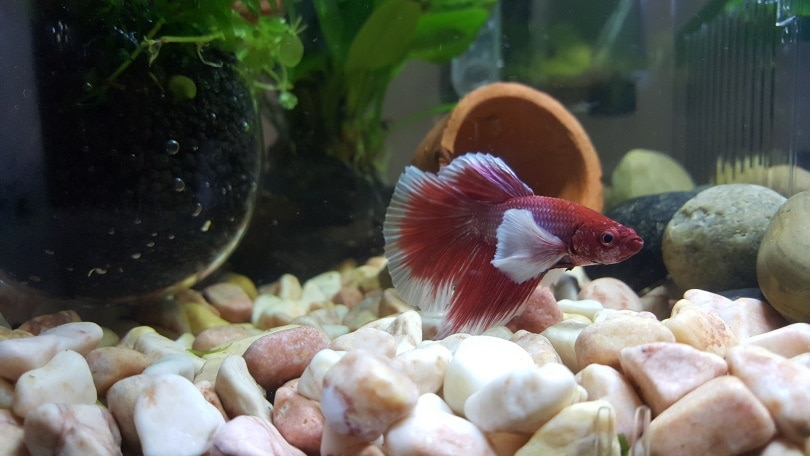
As is the case when you’re selecting any fish to share an environment, it’s essential that they all have similar requirements for thriving in a tank.
This means similar preferred temperature range, pH level, and tolerance of other fish. Eating the same food is not a requirement.
Shortly, we’ll give you a list of some of the best choices for a betta tank mate. But, if you prefer to choose your own, here’s a checklist of characteristics your new fish should have. Please note that all these criteria should be met before attempting to house bettas in a community setups.
- Not another betta
- Tropical fish that prefer similar temperatures, pH, and water parameters
- No long flowing fins that your betta may mistake as those of a rival
- Peaceful and not aggressive or territorial
- Not top dwellers
- Large enough aquarium to accommodate all the fish while meeting the needs of every species
- Other fish in the aquarium not being too large in size compared to your betta
The following factors may also be considered to increase the chances of a successful community setup:
- It is best to add the betta as the last fish to the aquarium. This way, the betta may view the tank mates as fish that already exist in a brand-new territory.
-
Aggressiveness is partly inherited in betta fish, so try to get a betta that has been housed with other fish before and is somewhat docile. Bettas that are overly aggressive should be housed alone, as they may not be good candidates for a community setup.
Female bettas require the same checklist, with one exception: They should either be the only betta in an aquarium, or they should be housed in a sorority of at least five or more females of the same size and age, all added to the aquarium at the same time.
The 12 Betta Fish Tank Mates Are:
We’ve broken this section down in three categories: extremely safe tank mates, usually acceptable tank mates, and short-term tankmates.
Extremely Safe Tank Mates
These aquatic pets are among the best candidates for being housed with bettas.
1. Ember Tetras (Hyphessobrycon amandae)
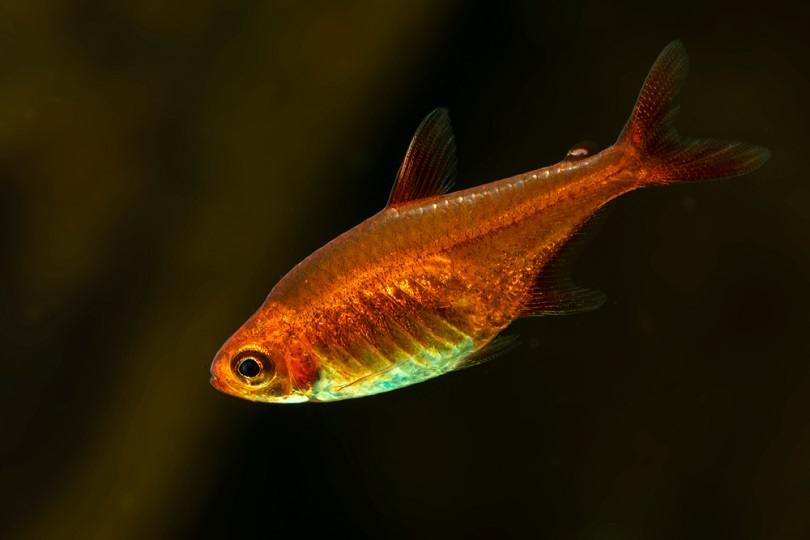
- Origin: Araguaia River, Brazil
- Maximum size: 0.8 inches (2 cm)
- Minimum Tank Size Required: 15 gallons for a group of 9-10
- pH of water required: Slightly acidic, near 6.6 is ideal
- Temperature requirements: 23–29 °C (73–84 °F).
- Care Level: Beginner
Ember tetras are attractive little fish, with a rusty reddish-orange hue. They are schooling fish, so it’s best to have several of them at any given time. Embers are omnivores, so they readily accept most tropical fish food of acceptable size. Feeding one or twice a day will be sufficient, and they’ll grab whatever sinks down to the middle of the tank.
They’re docile fish, and they like to hide, so make sure there are caves and plants for shelter. Since they’re river fish, an environment of rocks, plants, and driftwood would be suitable. Keep in mind they also like open spaces for swimming.
You shouldn’t see any interactions with your betta, Ember tetras being naturally passive. They mix well with other community fish.
2. Harlequin Rasbora (Trigonostigma heteromorpha)
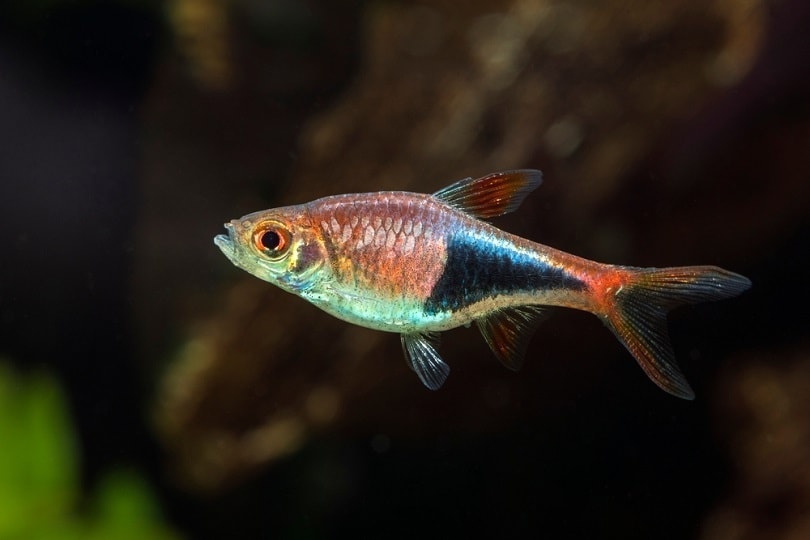
- Origin: Southeast Asia
- Maximum size: 2 inches (5 cm)
- Minimum Tank Size Required: 10 gallons for a school of 5-6
- pH of water required: 6.0 – 7.5
- Temperature requirements: 22 – 27 °C (72 – 81 °F)
- Care Level: Beginner
A chunky body with black triangle marks makes these fish very attractive to look at. It’s a schooling fish, so choose several specimens for maximum impact and comfort. It’s best to keep them away from large fish because their shimmer makes them appealing targets for predators.
They are peaceful creatures, and will not nip at your betta’s tail. Dense vegetation and low light simulate their natural habitat, but they do like a bit of open space, too.
You’ll find Harlequin Rasboras will eat almost anything you offer them, but we always recommend a varied diet for health and interest. Be aware that a healthy specimen may live as long as six years.
3. Kuhli Loach (Pangio kuhlii)
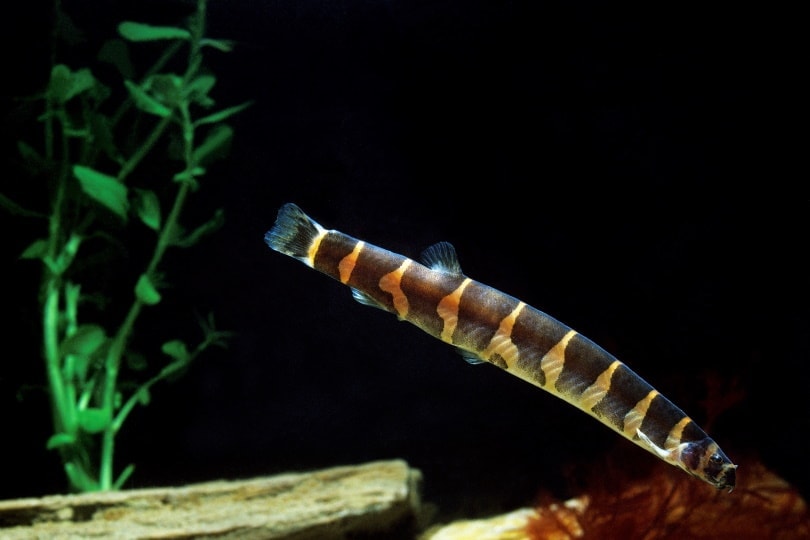
- Origin: Southeast Asia
- Maximum size: 4.5 inches (around 12 cm)
- Minimum Tank Size Required: 20 gallons for a school of 3-5
- pH of water required: 5.5 – 6.5
- Temperature requirements: 24 – 30 °C (75 – 86 °F)
- Care Level: Intermediate
The Kuhli loach is often mistaken for an eel, and it’s easy to see why. These long, slender, frisky fishes do seem to slither about, but they are from entirely separate families.
Kuhlis are yellowy-pink with dark stripes and light-colored bellies. They live at the bottom and love to burrow in the sand, or smooth stones. If you have enough space, you can keep a group of three or more kuhli loaches together. They are active at night, but not aggressive, making them excellent community fish.
They’ll eat almost anything, but sinking pellets and live foods are best. Feeding is best done in the evening when the lights are dim, as this is when they eat in the wild. Since they are also natural hiders, make sure there are caves and other nooks for them to slink into. Just make sure all surfaces are smooth, so they don’t scratch their delicate bodies.
Kuhli loaches are strong swimmers and can easily jump out of a tank if the lid isn’t completely sealed. Be sure the lid is tight and covers every opening to avoid an unpleasant surprise on the floor.
4. White Cloud Minnows (Tanichthys albonubes)
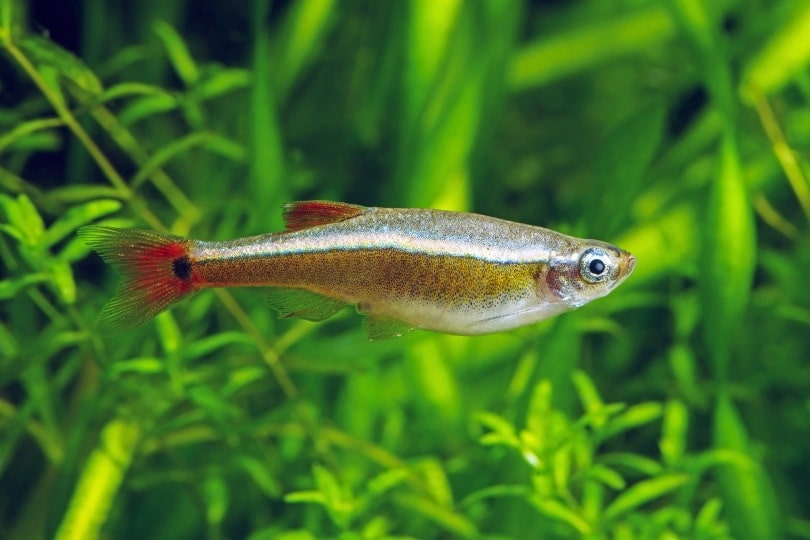
- Origin: China
- Maximum size: 1.5 inches (4 cm)
- Minimum Tank Size Required: 15 gallons for a school of 5-6
- pH of water required: a range, such as 6.0 – 8.0
- Temperature requirements: 64–72 °F (18–22 °C)
- Care Level: Intermediate
Sometimes called Chinese danios or “The Poor Man’s Neon Tetra”, White Cloud minnows are fun and easy fish to keep. They sport a nifty racing stripe down each side, and they tend to dart around and be very active. Kept in a school (as they prefer), they put on a great display.
They are omnivorous fish, so they’ll eat pretty much anything you have on hand. They’re also not fussy about where they eat or swim, and can be found at every level of the tank. Like guppies, they breed readily, though they lay eggs rather than give live birth.
White Cloud minnows are peaceful and make good community fish. They don’t get aggressive and are probably too fast to be caught by any would-be predators. If you choose them for your betta tank, be mindful of their unusually low water temperature requirements. You’ll need to keep the tank at the low end of what’s suitable for your betta. When housing them with Bettas, you should keep the aquarium at 77°F (25 °C) – they can comfortably tolerate this temperature even though it is outside their ideal range. On the other hand, bettas do not tolerate temperatures lower than this.
5. African Dwarf Frog (Hymenochirus curtipes)
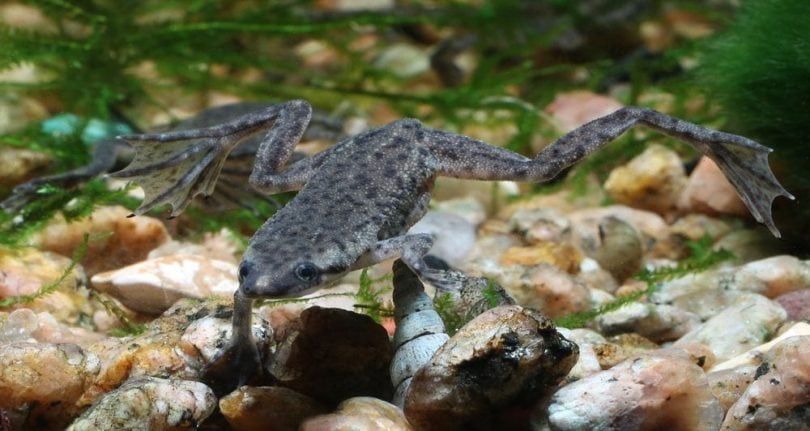
The African Dwarf Frog is a natural carrier of several species of Salmonella spp. For this reason, it is not advisable to keep them as pets when there are children or immunocompromised individuals in your house. Precautions with regards to personal hygiene should be taken when cleaning their aquarium. It is best to not touch these frogs unless absolutely necessary. To minimize the risk of contamination, their aquarium should not be placed near your kitchen or bathroom. Outbreaks have been reported by the CDC.
- Origin: Central Africa
- Maximum size: 2.5 -3 inches (6.3 – 7.6 cm), females are larger
- Minimum Tank Size Required: 10 gallons for a group of 3
- pH of water required: 6.5 – 7.5
- Temperature requirements: 75 – 82°F (23.8-27.8°C)
- Care Level: Intermediate
Adding these fully aquatic African dwarf frogs to your aquarium is a lot of fun, and they are entirely suitable betta fish tank mates. They tend to stick to the bottom of the tank, and they aren’t aggressive. They will, however, eat small fish, so they aren’t suitable for anyone who wants to hang on to fry. Despite the fact that they are called “frogs” they should be housed in an aquarium at all times. They are not suited for vivariums and will dry out and perish if removed from the water.
Being carnivorous, their diet comprises brine shrimp, bloodworms, krill, small worms, and any fish they can fit into their mouths. They shouldn’t be fed frozen or freeze-dried foods and will reject flakes. They lack teeth, and swallow their food whole. They are not aggressive or quick feeders, and when housed with fish that eat quickly, it can be difficult to ensure that they are well-fed.
6. Nerite (Zebra) Snails (Neritina natalensis)

- Origin: eastern and southern Africa
- Maximum size: 1 inch (2.5 cm), size of shell (not snail itself)
- Minimum Tank Size Required: 5 gallons
- pH of water required: 6.5 – 7.5
- Temperature requirements: 71 – 79 °F (22 to 26 °C)
- Care Level: Beginner
Just one of several varieties of nerite snails, Zebra snails are easily identified by their bold stripes. Many aquarists house snails just to keep the algae levels down, but they’re also interesting to watch, especially as they slide up and down the walls, and are perfect to live with betta fish.
They are non-aggressive, which isn’t too surprising, and once they’ve grown past the baby stage, nothing is likely to prey on them. As said above, they eat algae, so you shouldn’t introduce them to a new tank. Wait until algae have a chance to accumulate so they’ll have a ready source of food from day one.
Zebra snails aren’t fast, of course, but they do get around. It’s important to keep the lid closed to prevent them from escaping the tank.
You can keep many snails at once, and they won’t bother each other. Unlike many other snails, housing multiple snails will not lead to a population boom in your aquarium, as they require brackish water to reproduce and don’t reproduce in a freshwater setting.
7. Otocinclus
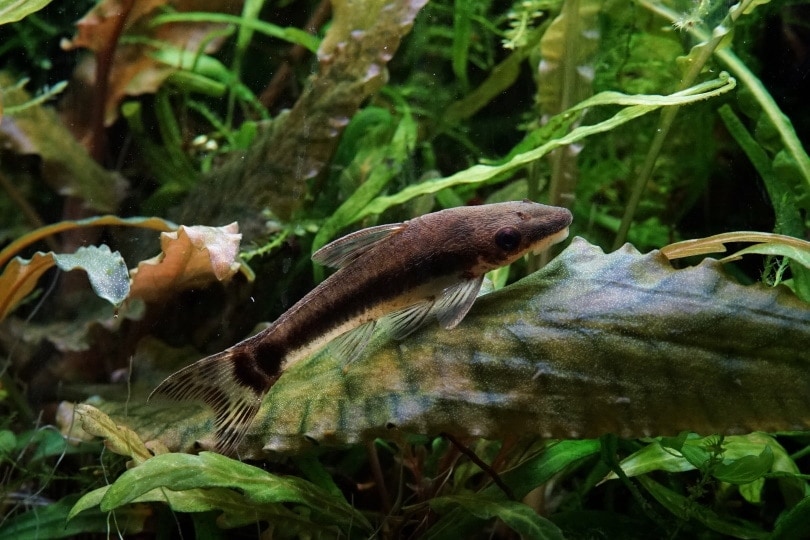
- Origin: South America
- Maximum size: 1 inch (2.5 cm) – 2 inches (5.5 cm) depending on species
- Minimum Tank Size Required: 15 gallons for a school of 5-6
- pH of water required: 6 – 7.5
- Temperature requirements: 72 – 84°F (22-29°C)
- Care Level: Intermediate
The term Otocinclus is a genus of several small catfish sometimes referred to as dwarf suckers. They are also referred to as ‘otos’. Otos tick just about every box needed to be considered suitable tank mates for a betta. Not only can they coexist in a similar environment, but they are exceptionally peaceful, making them fantastic tank mates for a betta. When housing these fish with a betta, it’s best to keep your tank at a temperature of around 82-83°F (approximately 28°C). This temperature is best for bettas (their ideal temperature is 82.4°F). A pH of around 7 is considered appropriate for both fish.
They naturally have a dull coloration which a betta wouldn’t misconstrue as that of a rival, and as an added bonus, they have an armored layer on their back, which can protect them from an inadvertent bite from a curious betta.
Being in a school comes with an added advantage: a curious betta may not know which oto to inspect, as it is difficult to single out a target from a school of fish. They are also relatively fast swimmers when compared to a betta. All these advantages are further augmented by the fact that they are likely not going to show any interest in whatever your betta eats, as they are herbivores.
Usually Acceptable Tank Mates
These fish can often be housed with bettas without much issue, however caution is advised because at times they may interact unfavorably with each other, for reasons we will discuss
8. Corydoras Catfish (Corydoras spp.)
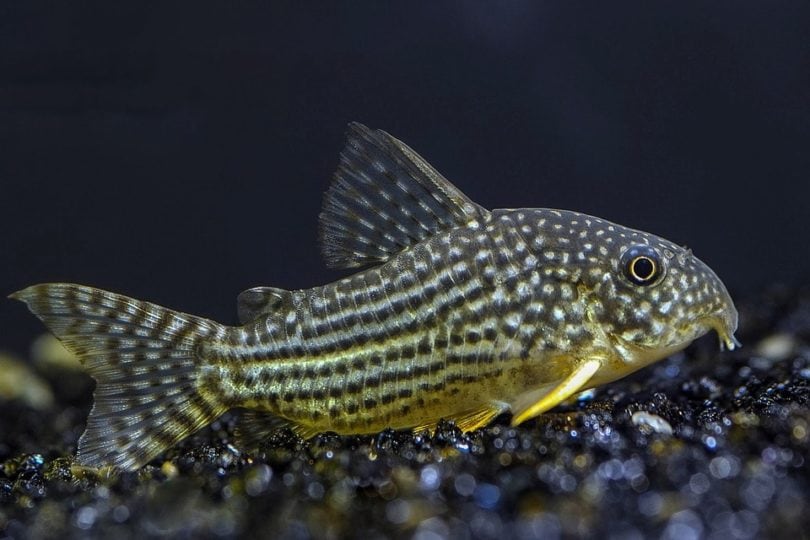
- Origin: South America
- Maximum size: 1 to 4.7 inches (2.5 – 12 cm), depending on species
- Minimum Tank Size Required: 15+ gallons for a group of 5-6 of the smallest size (Pygmy Corydoras)
- pH of water required: 6.0 – 8.0
- Temperature requirements: 72 – 78°F (22 – 26°C)
- Care Level: Beginner
There are many different species of corydoras. So many, in fact, a lot of them just have numbers instead of names. They differ in appearance, but most of them have pretty much the same characteristics. Just choose healthy specimens whose appearance catches your eye.
As with most catfish, they are bottom dwellers and feeders. They eat algae and whatever else drifts to the bottom. You should offer good algae chips, too, to keep them healthy and happy. Some species may also enjoy live or frozen protein. Keep an eye on them to see what they prefer.
Cory catfish are schooling fish, so you’ll want to pick up several at once. They are very peaceful, and will not pester each other, or your betta. Since they live at the bottom, they may not bump into your betta very often, although they will sometimes dart to the surface for a gulp of oxygen. This kind of behavior makes them very entertaining to watch.
They are somewhat controversial when housed with other fish because all Corys have a stinger near their eye. If startled, they can sting a perceived threat with this stinger, which contains a toxin. There is little risk for humans when it comes to this toxin (though you may feel the sting). Other fish that are stung may perish. Some species of Corys, such as the Sterbai, use this toxin more readily than others. Panda, Leopard, or Pygmy corys are recommended over Sterbai.
9. Bristlenose Pleco (Ancistrus cirrhosus)
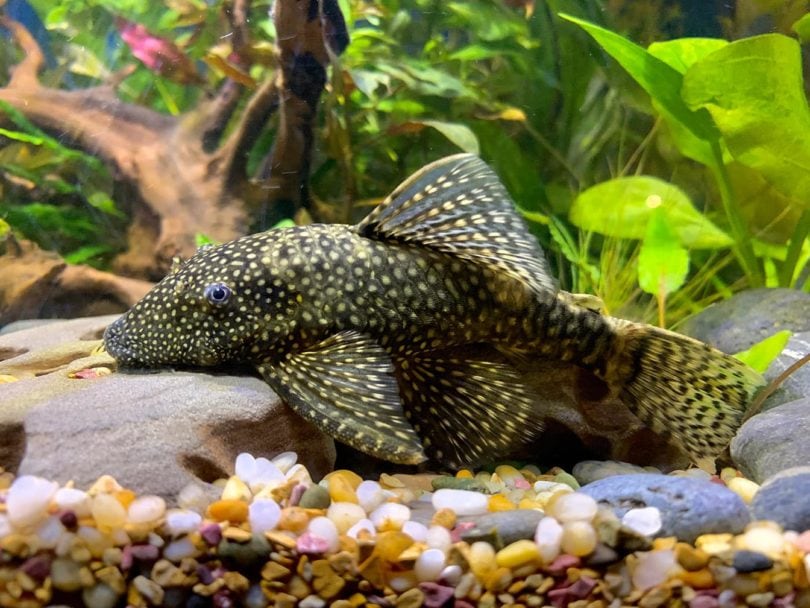
- Origin: Amazon River, Brazil
- Maximum size: 6 inches
- Minimum Tank Size Required: 30 gallons
- pH of water required: 6.0 – 8.0
- Temperature requirements: 68 – 77°F (20 – 25°C)
- Care Level: Beginner
This peaceful bottom-dweller is a lot of fun to keep and is quite striking in appearance. They’re covered in small spots, have spiky snouts, and large fins.
As with other plecos, they need their own space, so only very large tanks should have more than one Bristlenose. Make sure to provide a cave or other hollow spot for hiding and resting. They may dig in the substrate, but don’t usually bury themselves.
When young, they are useful and help clean up algae, which they do by feeding on it wherever it grows: rocks, decorations, the walls – anywhere. They will also nibble on any driftwood you use as décor. You’ll also want to provide algae chips (most tanks aren’t “dirty” enough to sustain them with naturally occurring food) and fresh veg like cucumbers and zucchini. Many aquarists consider driftwood mandatory for them.
Bristlenose plecos seem to get along with most other docile fish, or at least they ignore them. They’re great for “layering” fish; betta at the top, schooling fish in the middle, pleco at the bottom. But don’t be surprised if you don’t see them active during the day, as they are relatively shy and prefer the cover of darkness.
Bristlenose Plecos are risky when housed with bettas because they get territorial as they mature, and may eventually attack your betta. This risk is much higher when housing a male rather than a female. As males mature, they tend to claim a space as “their own” and attack other fish that try to intrude (except a female). This is due to their reproductive physiology, eggs are guarded by the male so they don’t appreciate other fish in their space. Fortunately, they are very easy to sex: females rarely have bristles, and will only have them around their chin. Males have bristles up the center of their head.
10. Ghost Shrimp (Palaemontes sp.)
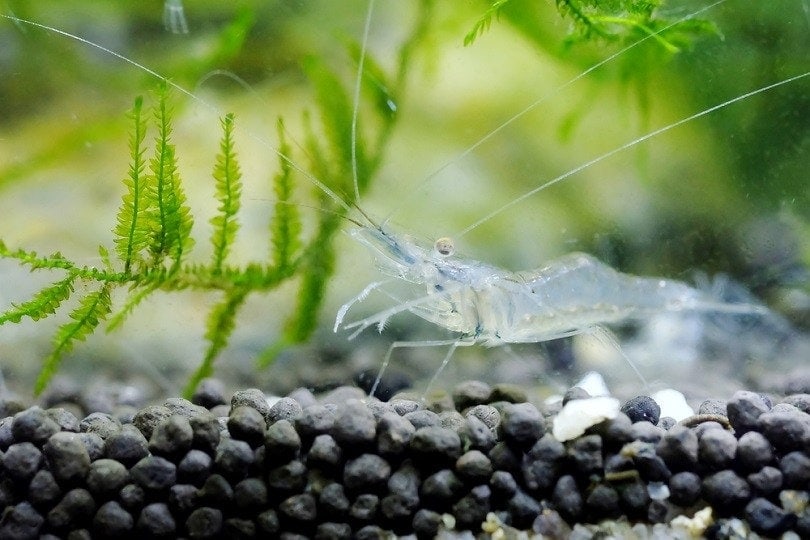
- Origin: North America
- Maximum size: 2 inches
- Minimum Tank Size Required: 5 gallons
- pH of water required: 6.5 – 8.0
- Temperature requirements: 65 – 80°F (18- 27°C)
- Care Level: Beginner
Also called glass shrimp, these fascinating creatures are nearly see-through and are just one of many recommended shrimp compatible with betta fish. As you’d expect, they spend their days crawling around the bottom of the tank, and they’ll scavenge a meal wherever they can find one. Try sinking pellets, but don’t expect them to go for algae wafers.
If your tank is large enough, you can have more than one. If crowded, however, they may become aggressive toward others of the same species. Males and females will breed without any effort on your part, but you’ll have to remove the pregnant female to another tank or else the eggs or babies will become snacks for your fish.
Large fish will also prey on adult ghost shrimp so don’t include shrimp in a community tank with the big boys. They like to burrow and build their own nests, so choose sand or small gravel for substrate. If you went with marbles, shrimp are not a good choice for betta mates.
Ghost shrimp are active little creatures, though they won’t stray far from home. They are a fun alternative to fish, and really liven up a tank.
They aren’t recommended with Bettas for two reasons:
- Bettas may misconstrue them as a snack, especially if they are juveniles. Separate them if this happens.
- Many ghost shrimp are bred and raised in poor conditions and are associated with introducing unwanted pathogens to aquariums.
11. Red Cherry Shrimp (Neocaridina denticulate sinensis)
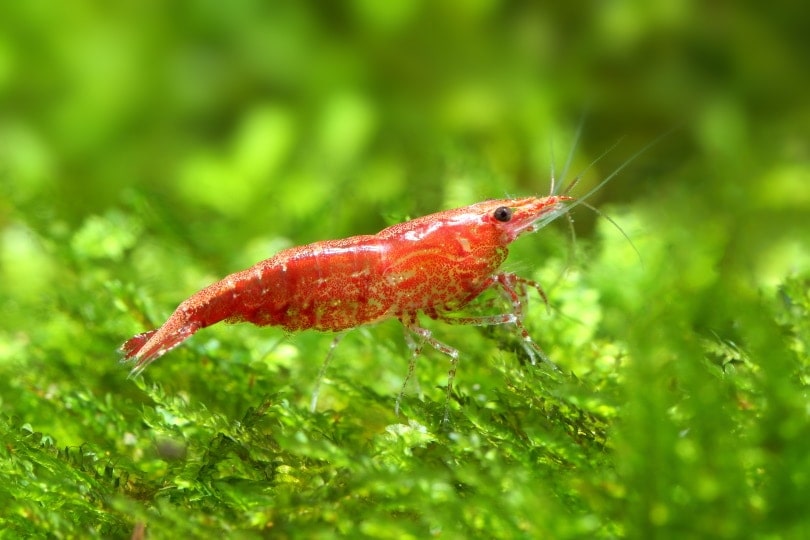
- Origin: Taiwan
- Maximum size: 1.25 inches
- Minimum Tank Size Required: 1 gallon
- pH of water required: 7 – 8.0
- Temperature requirements: 70 – 80°F (21 – 27°C)
- Care Level: Beginner
Another fun alternative to more fish, Red Cherry Shrimp are colorful, active additions to any community tank. They tend to stick to the bottom, far away from your betta. Give them some plants to climb, however, and they’ll go exploring.
They like to eat algae and other naturally occurring organics growing on driftwood and rocks, plus you can toss them sinking pellets for variety. Red Cherry shrimp breed easily, but don’t expect the babies to last long if they aren’t removed from the tank.
Red Cherry shrimp are peaceful, and won’t harm other fish or each other. Big fish will prey on them, but you don’t want big fish with your betta, anyway.
The biggest risk with housing these shrimp with Bettas is that a Betta will almost always assume a young shrimp is a meal. They need plenty of cover from a Betta, and you should only house full grown individuals with your Betta. Newborn shrimp may not last long in your aquarium as many fish view them as a meal.
Short-Term Tank Mates
These fish can be housed with Bettas on a temporary basis only.
12. Most Plecos (Plecostomus)
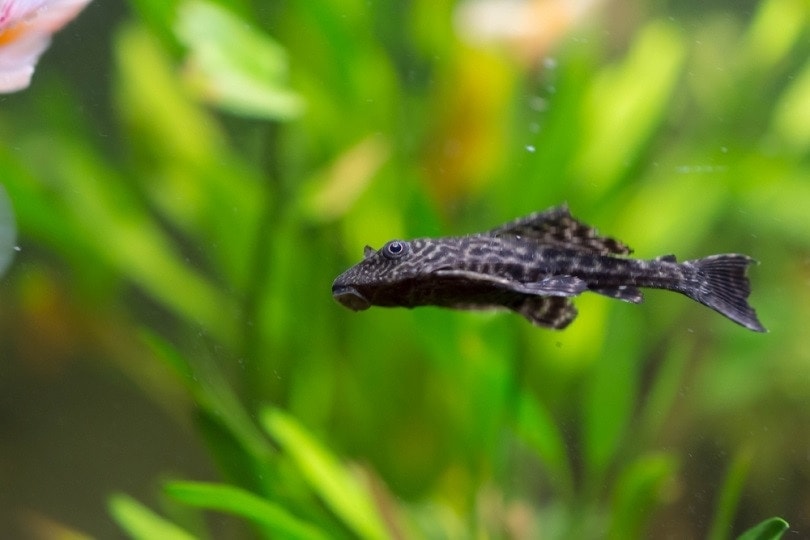
- Origin: Varies
- Maximum size: Up to 24 inches (depending on species)
- Minimum Tank Size Required: Up to 150 gallons (depending on species)
- pH of water required: 6.8 – 7.6
- Temperature requirements: 73 – 82°F (23 – 28°C)
- Care Level: Intermediate
While they aren’t flashy, Plecos are a lot of fun to have in an aquarium. Most of them grow to a moderate size but will look like giants compared to small, schooling fish like tetras. While they spend a lot of time just hanging around, they also can be quite active when they’re feeding.
Plecos are not considered good tank mates for bettas on a long-term basis for several reasons. For one thing, many pleco species are peaceful when young (usually when they’re purchased) but tend to get more aggressive and territorial when they’re older. This makes them a long-term risk for bettas.
Other issues that make them incompatible long-term companions include the following:
- Contrary to popular belief, plecos are not herbivores. They can attack other fish and are known to remove the slime coat from tank mates at times. A slow-moving betta can make for an easy target.
- Plecos have a high bioload and are exceptionally messy (even though they are marketed as “cleaner fish”). Many species grow way too large for an aquarium that a betta would be typically housed in. For example, the common pleco grows big enough to require a 150-gallon tank!
- Plecos have spines that can sometimes get caught in a sponge filter, which most people prefer to use with bettas.
- Male plecos in particular are aggressive when they are guarding a potential breeding site and will readily attack other fish.
For these reasons, most plecos can only be housed with a betta for about 6 months on average before they must be rehomed.
What Fish Should Not Be Kept With A Betta?
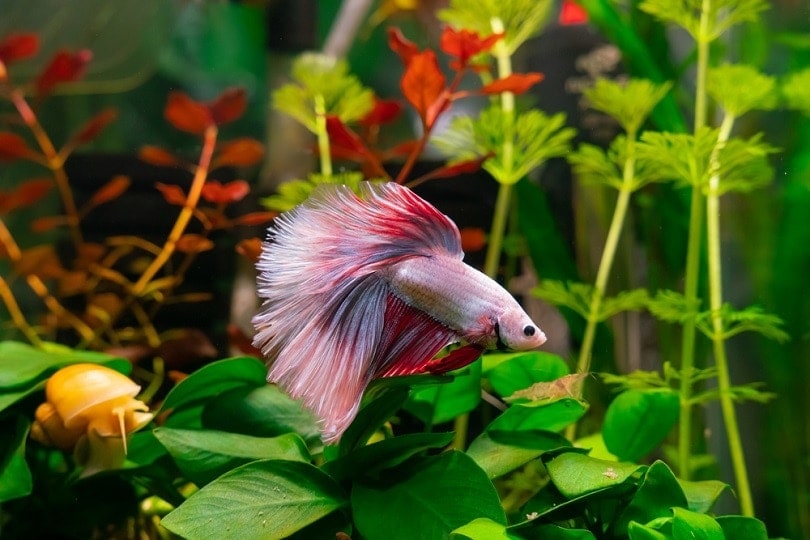
Now that you have an idea of what fish you can keep with a betta, here’s a list of some fish you absolutely should not include in your community.
Reasons for their exclusion run from being too aggressive, too colorful, or too similar in appearance (and hence looking like a threat), to simply requiring too different a habitat to thrive.
Here they are, in no particular order:
- Goldfish
- Gouramis
- Cichlids
- Tiger Barbs
- Clownfish
- Any cichlid (oscars, African cichlids, convicts, etc.)
- Fancy guppies
- Chinese algae eater
- Flying fox
- Whiptail catfish
- Red-tailed black shark
- Rainbow shark
- Endler
- Black skirt tetras
The Last Word on Betta Tank Mates
Now that you know who can and who cannot live with bettas, we hope you’re inspired to go forth and create a happy, healthy environment for your aquatic companions.
On the flip side of the same coin, if you’ve learned that your betta is perfectly happy to have just you for company, that’s great, too!
Featured Image Credit: Marko25, Shutterstock



